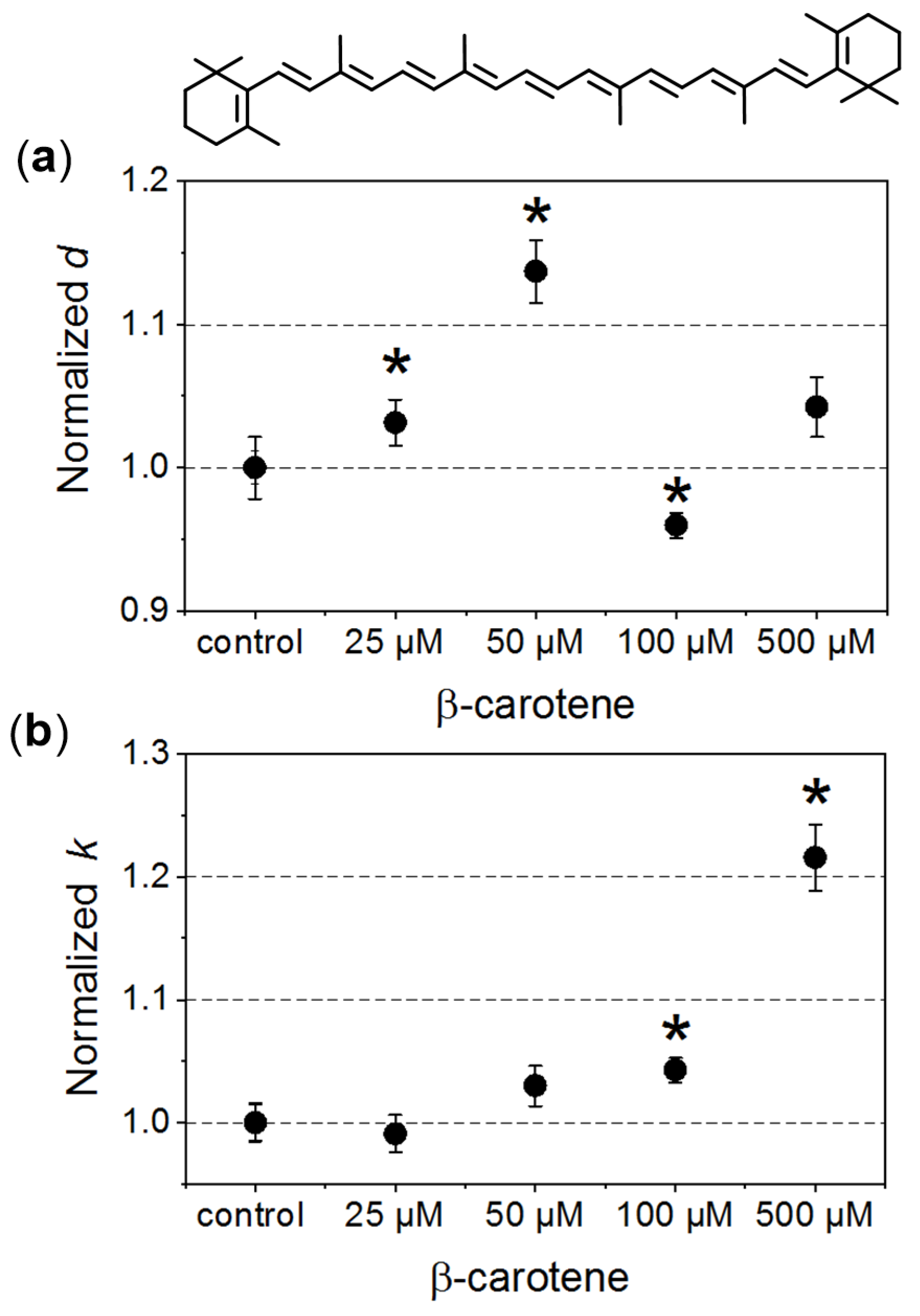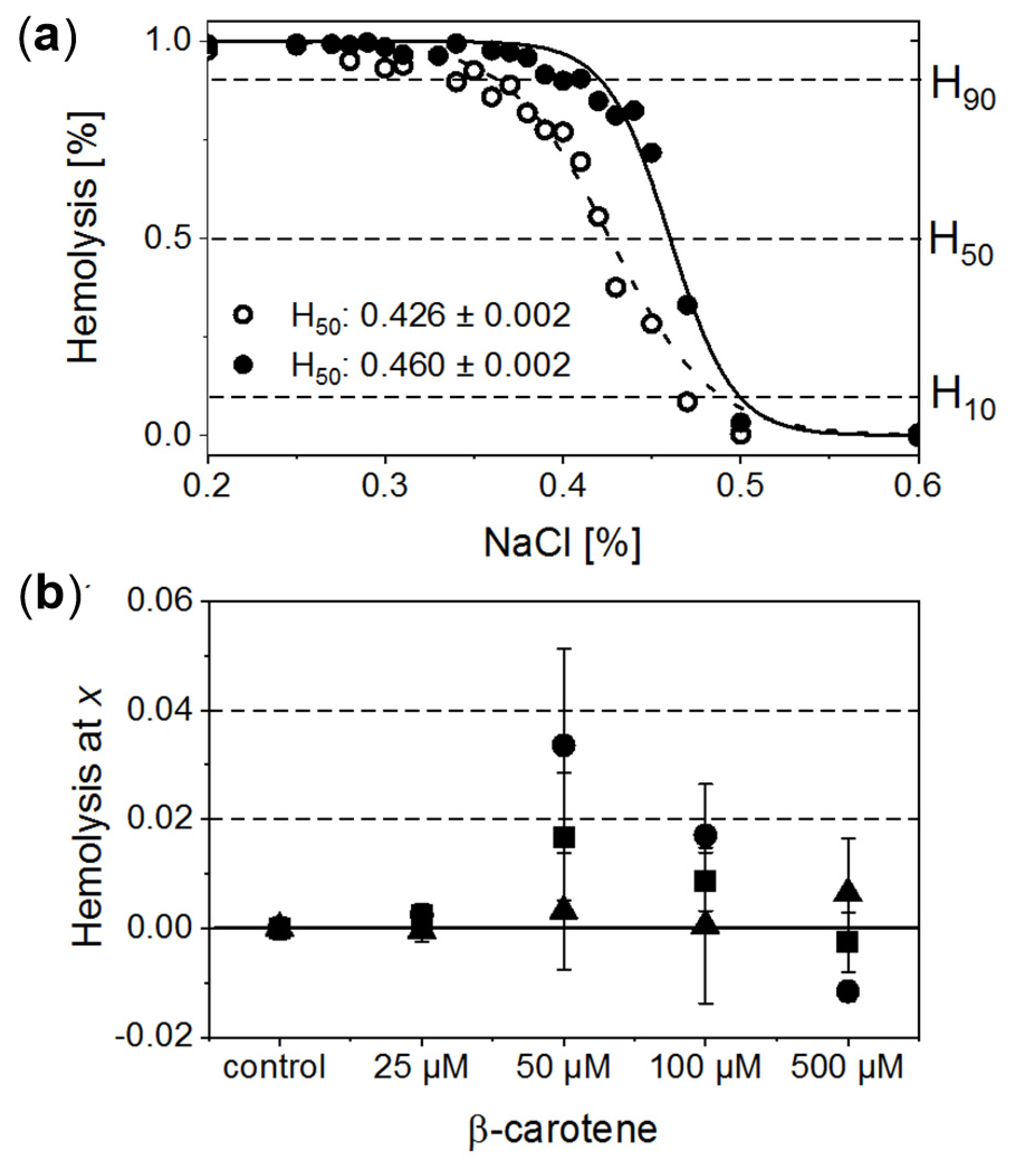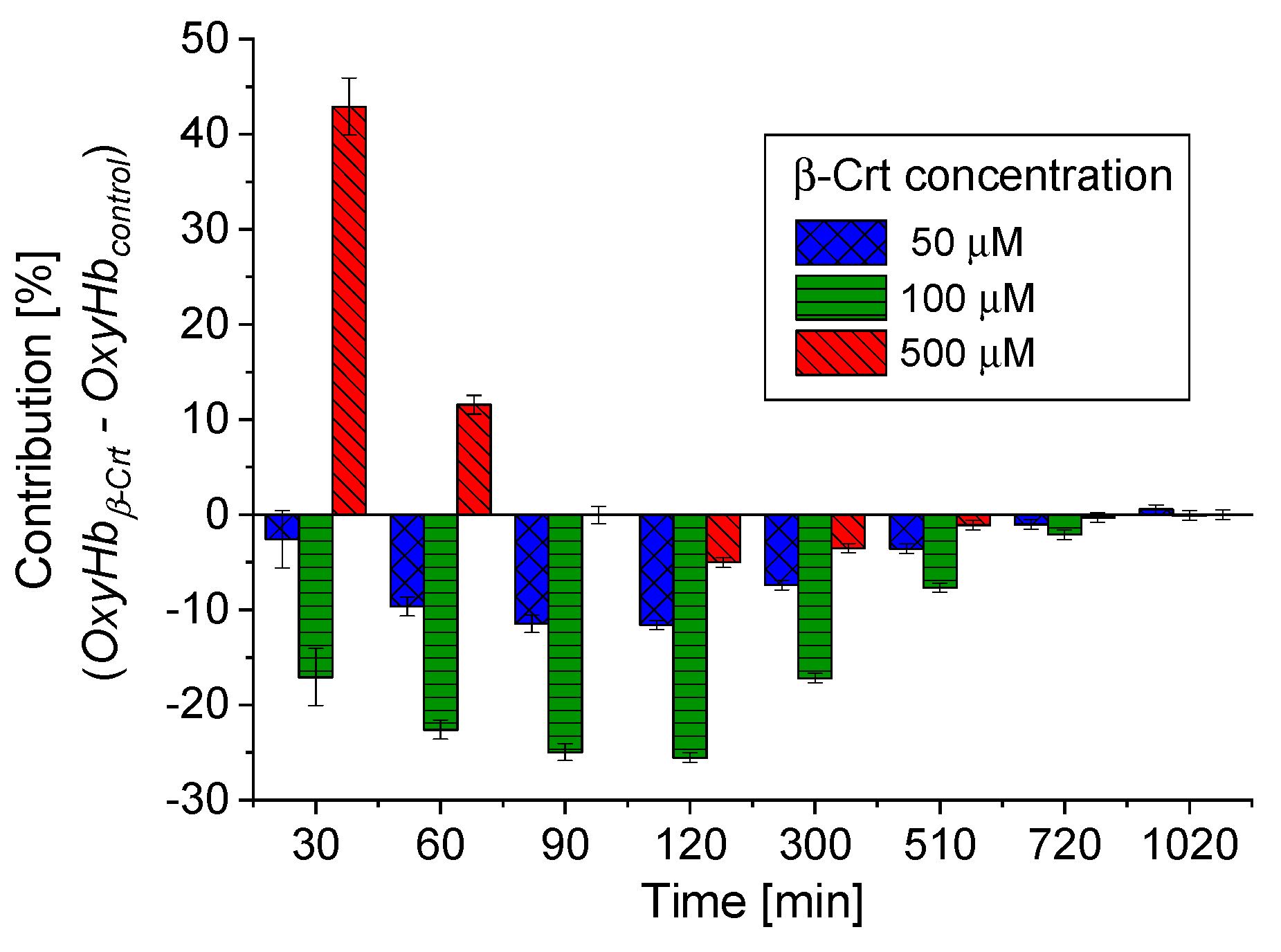β-Carotene-Induced Alterations in Haemoglobin Affinity to O2
Abstract
1. Introduction
2. Materials and Methods
2.1. Sample Preparation
2.2. Optical Imaging of RBCs
2.3. Osmotic Fragility Test
2.4. Mössbauer Spectroscopy
3. Results and Discussion
3.1. Morphometric and Osmotic Fragility Analyses
3.2. Mössbauer Spectroscopy
Author Contributions
Funding
Institutional Review Board Statement
Informed Consent Statement
Acknowledgments
Conflicts of Interest
References
- Landrum, J.T. (Ed.) Carotenoids. Physical, Chemical, and Biological Functions and Properties; CRC Press, Taylor & Francis Group: Boca Raton, FL, USA, 2010. [Google Scholar]
- Fiedor, J.; Fiedor, L.; Haessner, R.; Scheer, H. Cyclic enodperoxides of b-carotene, potential pro-oxidants, as products of chemical quenching of singlet oxygen. Biochim. Biophys. Acta 2005, 1709, 1–4. [Google Scholar] [CrossRef]
- Edge, R.; Truscott, T. Singlet oxygen and free radical reactions of retinoids and carotenoids—A review. Antioxidants 2018, 7, 5. [Google Scholar] [CrossRef] [PubMed]
- Fiedor, J.; Burda, K. Potential role of carotenoids as antioxidants in human health and disease. Nutrients 2014, 6, 466–488. [Google Scholar] [CrossRef]
- Palozza, P.; Calviello, G.; Bartoli, G.M. Prooxidant activity of b-carotene under 100% oxygen pressure in rat liver microsomes. Free Rad. Biol. Med. 1995, 19, 887–892. [Google Scholar] [CrossRef]
- Albanes, D.; Heinonen, O.P.; Taylor, P.R.; Virtamo, J.; Edwards, B.K.; Rautalahti, M.; Hartman, A.M.; Palmgren, J.; Freedman, L.S.; Haapakoski, J.; et al. α-Tocopherol and β-Carotene Supplements and Lung Cancer Incidence in the Alpha-Tocopherol, Beta-Carotene Cancer Prevention Study: Effects of Base-line Characteristics and Study Compliance. J. Nat. Cancer Inst. 1996, 88, 1560–1570. [Google Scholar] [CrossRef]
- Omenn, G.S.; Goodman, G.E.; Thornquist, M.D.; Balmes, J.; Cullen, M.R.; Glass, A.; Keogh, J.P.; Meyskens, F.L.J.; Valanis, B.; Williams, J.H.J.; et al. Risk factors for lung cancer and for intervention effects in CARET, the Beta-Carotene and Retinol Efficacy Trial. J. Nat. Cancer Inst. 1996, 88, 1550–1559. [Google Scholar] [CrossRef] [PubMed]
- Gruszecki, W.; Strzałka, K. Carotenoids as modulators of lipid membrane physical properties. Biochim. Biophys. Acta 2005, 1740, 108–115. [Google Scholar] [CrossRef] [PubMed]
- Gabrielska, J.; Gruszecki, W. Zeaxanthin (dihydroxy-beta-carotene) but not beta-carotene rigidifies lipid membranes: A 1H-NMR study of carotenoid-egg phosphatidylcholine liposomes. Biochim. Biophys. Acta 1996, 1285, 167–174. [Google Scholar] [CrossRef]
- Berglund, A.; Nilsson, R.; Liljenberg, C. Permeability of large unilamellar digalactosyldiacylglycerol vesicles for protons and glucose—Influence of a-tocopherol, b-carotene, zeaxanthin and cholesterol. Plant Physiol. Biochem. 1999, 37, 179–186. [Google Scholar] [CrossRef]
- Lux IV, S.E. Anatomy of the red cell membrane skeleton: Unanswered questions. Blood 2016, 127, 187–199. [Google Scholar] [CrossRef]
- Diez-Silva, M.; Dao, M.; Han, J.; Lim, C.-T.; Suresh, S. Shape and biomechanical characteristics of human red blood cells in health and disease. MRS Bull. 2010, 35, 382–388. [Google Scholar] [CrossRef] [PubMed]
- Kaczmarska, M.; Fornal, M.; Messerli, F.H.; Korecki, J.; Grodzicki, T.; Burda, K. Erythrocyte membrane properties in patients with essential hypertension. Cell Biochem. Biophys. 2013, 67, 1089–1102. [Google Scholar] [CrossRef]
- Walder, J.A.; Chatterjee, R.; Steck, T.L.; Low, P.S.; Musso, G.F.; Kaiser, E.T.; Rogers, P.H.; Arnone, A. The interaction of hemoglobin with the cytoplasmic domain of band 3 of the human erythrocyte membrane. J. Biol. Chem. 1984, 259, 10238–10246. [Google Scholar] [CrossRef]
- Chu, H.; Breite, A.; Ciraolo, P.; Franco, R.S.; Low, P.S. Characterization of the deoxyhemoglobin binding site on human erythrocyte band 3: Implications for O2 regulation of erythrocyte properties. Blood 2008, 111, 932–938. [Google Scholar] [CrossRef] [PubMed]
- Chetrite, G.; Cassoly, R. Affinity of hemoglobin for the cytoplasmic fragment of human erythrocyte membrane band 3. Equilibrium measurements at physiological pH using matrixbound proteins: The effects of ionic strength, deoxygenation and of 2,3-diphosphoglycerate. J. Mol. Biol. 1985, 185, 639–644. [Google Scholar] [CrossRef]
- Ahmed, M.H.; Ghatge, M.S.; Safo, M.K. Hemoglobin: Structure, fuction and allostery. Subcell Biochem. 2020, 94, 345–382. [Google Scholar] [CrossRef]
- Lang, G.; Marshall, W. Mössbauer effect in some hemoglobin compounds. Proc. Phys. Soc. 1966, 87, 3–34. [Google Scholar] [CrossRef]
- Burda, K.; Hrynkiewicz, A.; Kołoczek, H.; Stanek, J.; Strzałka, K. Mixed valence state in ironporphyrin aggregates. Biochim. Biophys. Acta 1995, 1244, 345–350. [Google Scholar] [CrossRef]
- Bauminger, E.R.; Nowik, I. Iron in Parkinson disease, blood diseases, malaria and ferritin. Hyperfine Inter. 1998, 111, 159–170. [Google Scholar] [CrossRef]
- Vogel, D.J.; Formenti, F.; Retter, A.J.; Vasques, F.; Camporota, L. A left shift in the oxyhaemoglobin dissociation curve in patients with severe coronavirus disease 2019 (COVID-19). Br. J. Haematol. 2020, 191, 390–393. [Google Scholar] [CrossRef]
- Burda, K.; Lekki, J.; Cieślak, J.; Kruk, J.; Lekka, M.; Dubiel, S.; Stanek, J.; Stachura, Z. Molecular mechanism of hemolysis induced by triphenyltin chloride. Appl. Organomet. Chem. 2002, 16, 148–154. [Google Scholar] [CrossRef]
- Eggersdorfer, M.; Wyss, A. Carotenoids in human nutrition and health. Arch. Biochem. Biophys. 2018, 652, 18–26. [Google Scholar] [CrossRef] [PubMed]
- Sonmez, M.; Ince, H.Y.; Yalcin, O.; Ajdzanovic, V.; Spasojevic, I.; Meiselman, H.J.; Baskurt, O.K. The effect of alcohols on red blood cell mechanical properties and membrane fluidity depends on their molecular size. PLoS ONE 2013, 8, e76579. [Google Scholar] [CrossRef] [PubMed]
- Parpart, A.K.; Lorenz, P.B.; Parpart, E.R.; Gregg, J.R.; Chase, A.M. The osmotic resistance (fragility) of human red cells. J. Clin. Investig. 1947, 26, 636–640. [Google Scholar] [CrossRef] [PubMed]
- Kaczmarska, M.; Kopyściańska, Z.; Fornal, M.; Grodzicki, T.; Matlak, K.; Korecki, J.; Burda, K. Effects of low doses of gamma rays on the stability of normal and diabetic erythrocytes. Acta Biochim. Pol. 2011, 58, 489–496. [Google Scholar] [CrossRef] [PubMed]
- Rancourt, D.G.; Ping, J.Y. Voigt-based methods for arbitrary-shape static hyperfine parameter distributions in Mössbauer spectroscopy. Nucl. Instrum. Meth. 1991, 58, 85–87. [Google Scholar] [CrossRef]
- Mostofian, B.; Johnson, Q.R.; Smith, J.C.; Cheng, X. Carotenoids promote lateral packing and condensation of lipid membranes. Phys. Chem. Chem. Phys. 2020, 22, 12281–12293. [Google Scholar] [CrossRef]
- Augustynska, D.; Jemiola-Rzeminska, M.; Burda, K.; Strzałka, K. Influence of polar and nonpolar carotenoids on structural and adhesive properties of model membranes. Chem. Biol. Interac. 2015, 239, 19–25. [Google Scholar] [CrossRef]
- Lopes de Almeida, J.P.; Freitas-Santos, T.; Saldanha, C. Erythrocyte deformability dependence on band 3 protein in an in-vitro model of hyperfibrinogenemia. Clin. Hemorhol. Microcirc. 2012, 50, 213–219. [Google Scholar] [CrossRef] [PubMed]
- Kodippili, G.C.; Spector, J.; Hale, J.; Giger, K.; Hughes, M.R.; McNagny, K.M.; Brikenmeier, C.; Peters, L.; Ritchie, K.; Low, P.S. Analysis of the mobilities of band 3 populations associated with ankyrin protein and junctional complexes in intact murine erythrocytes. J. Biol. Chem. 2012, 287, 4129–4138. [Google Scholar] [CrossRef] [PubMed]
- Niemiec, K.; Kaczmarska, M.; Buczkowski, M.; Fornal, M.; Pohorecki, W.; Matlak, K.; Korecki, J.; Grodzicki, T.; Burda, K. Mössbauer studies of hemoglobin in erythrocytes exposed to neutron radiation. Hyperfine Inter. 2012, 206, 95–100. [Google Scholar] [CrossRef]
- Mairbaurl, H.; Weber, R.E. Oxygen transport by hemoglobin. Compr. Physiol. 2012, 2, 1463–1489. [Google Scholar] [CrossRef]
- Mairbaurl, H.; Oelz, O.; Bartsch, P. Intercations between Hb, Mg, DPG, ATP and Cl determine the change in Hb–O2 affinity at high altitude. J. Appl. Physiol. 1993, 74, 40–48. [Google Scholar] [CrossRef] [PubMed]
- Rybicki, A.C.; Qiu, J.J.H.; Musto, S.; Rosen, N.L.; Nagel, R.L.; Schwartz, R.S. Human Erythrocyte Protein 4.2 Deficiency Associated With Hemolytic Anemia and a Homozygous 40Glutamic Acid → Lysine Substitution in the Cytoplasmic Domain of Band 3 (Band 3Montefiore). Blood 1993, 81, 2155–2165. [Google Scholar] [CrossRef] [PubMed]
- Jarolim, P.; Murray, J.L.; Rubin, H.L.; Taylor, W.M.; Prchal, J.T.; Ballas, S.K.; Snyder, L.M.; Chrobak, L.; Melrose, W.D.; Brabec, V.; et al. Characterization of 13 novel band 3 gene defects in hereditary spherocytosis with band 3 deficiency. Blood 1996, 88, 4366–4374. [Google Scholar] [CrossRef]
- Eaton, J.W.; Skelton, T.D.; Berger, E. Survival at extreme altitude: Protective effect of increased hemoglobin-oxygen affinity. Science 1974, 183, 743–744. [Google Scholar] [CrossRef]
- Samaja, M.; Crespi, T.; Guazzi, M.; Vandegriff, K.D. Oxygen transport in blood at high altitude: Role of the hemoglobin–oxygen affinity and impact of the phenomena related to hemoglobin allosterism and red cell functio. Eur. J. Appl. Physiol. 2003, 90, 351–359. [Google Scholar] [CrossRef]
- Wang, X.-D.; Russell, R.M. Procarcinogenic and anticarcinogenic effects of b-carotene. Nutr. Rev. 1999, 57, 263–272. [Google Scholar] [CrossRef]
- Siems, W.; Wiswedel, I.; Salerno, C.; Crifo, C.; Augustin, W.; Schild, L.; Langhans, C.-D.; Sommerburg, O. β-Carotene breakdown products may impair mitochondrial functions—Potential side effects of high-dose β-carotene supplementation. J. Nutr. Biochem. 2005, 16, 385–397. [Google Scholar] [CrossRef]
- Scientific Committee on Food. Opinion of the Scientific Committee on Food on the Safety of Use of Beta Carotene from All Dietary Sources; SCF/CS/ADD/COL/159 Final; European Commission: Brussels, Belgium, 2000; pp. 1–28. [Google Scholar]
- Martini, M.C.; Campbell, D.R.; Gross, M.D.; Grandits, G.A.; Potter, J.D.; Slavin, J.L. Plasma carotenoids as biomarkers of vegetable intake: The Univeristy of Minnesota Cancer Prevention Research Unit Feeding Studies. Cancer Epidemiol. Biomark. Prev. 1995, 4, 491–496. [Google Scholar]
- Murata, T.; Tamai, H.; Morinobu, T.; Manago, M.; Takenaka, A.; Takenaka, H.; Mino, M. Determination of b-carotene in plasma, blood cells and buccal mucosa by electrochemical detection. Lipids 1992, 27, 840–843. [Google Scholar] [CrossRef] [PubMed]





Publisher’s Note: MDPI stays neutral with regard to jurisdictional claims in published maps and institutional affiliations. |
© 2021 by the authors. Licensee MDPI, Basel, Switzerland. This article is an open access article distributed under the terms and conditions of the Creative Commons Attribution (CC BY) license (http://creativecommons.org/licenses/by/4.0/).
Share and Cite
Fiedor, J.; Przetocki, M.; Siniarski, A.; Gajos, G.; Spiridis, N.; Freindl, K.; Burda, K. β-Carotene-Induced Alterations in Haemoglobin Affinity to O2. Antioxidants 2021, 10, 451. https://doi.org/10.3390/antiox10030451
Fiedor J, Przetocki M, Siniarski A, Gajos G, Spiridis N, Freindl K, Burda K. β-Carotene-Induced Alterations in Haemoglobin Affinity to O2. Antioxidants. 2021; 10(3):451. https://doi.org/10.3390/antiox10030451
Chicago/Turabian StyleFiedor, Joanna, Mateusz Przetocki, Aleksander Siniarski, Grzegorz Gajos, Nika Spiridis, Kinga Freindl, and Kvetoslava Burda. 2021. "β-Carotene-Induced Alterations in Haemoglobin Affinity to O2" Antioxidants 10, no. 3: 451. https://doi.org/10.3390/antiox10030451
APA StyleFiedor, J., Przetocki, M., Siniarski, A., Gajos, G., Spiridis, N., Freindl, K., & Burda, K. (2021). β-Carotene-Induced Alterations in Haemoglobin Affinity to O2. Antioxidants, 10(3), 451. https://doi.org/10.3390/antiox10030451






